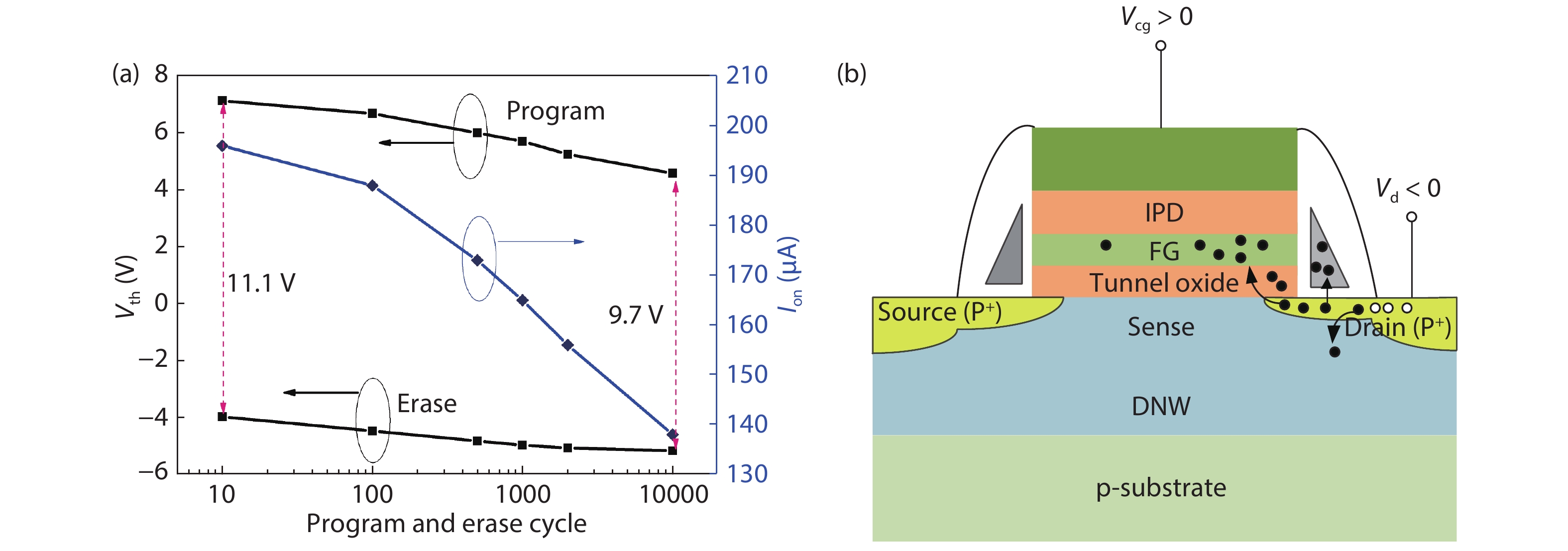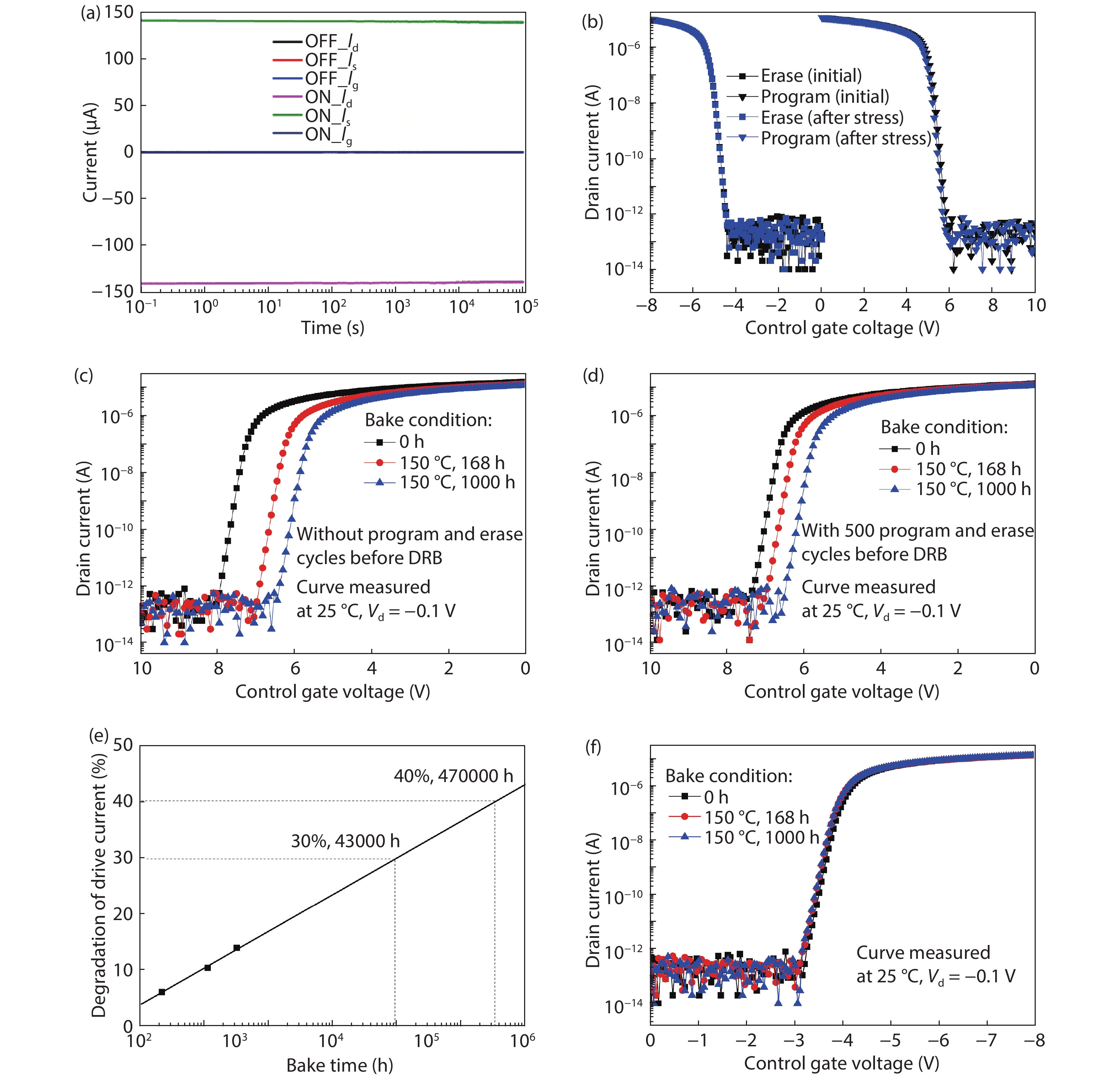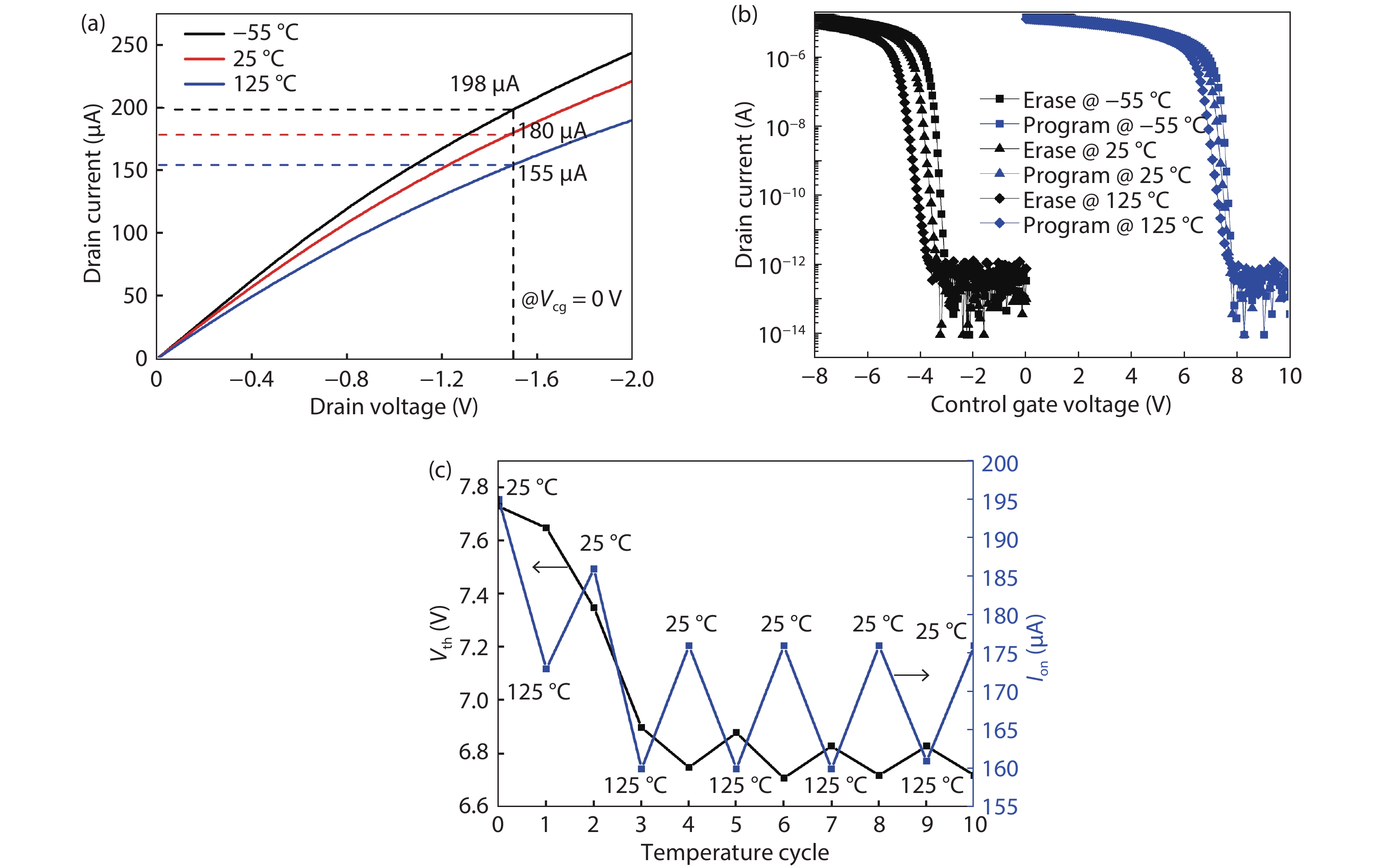| Citation: |
Side Song, Guozhu Liu, Hailiang Zhang, Lichao Chao, Jinghe Wei, Wei Zhao, Genshen Hong, Qi He. Reliability evaluation on sense-switch p-channel flash[J]. Journal of Semiconductors, 2021, 42(8): 084101. doi: 10.1088/1674-4926/42/8/084101
****
S D Song, G Z Liu, H L Zhang, L C Chao, J H Wei, W Zhao, G S Hong, Q He, Reliability evaluation on sense-switch p-channel flash[J]. J. Semicond., 2021, 42(8): 084101. doi: 10.1088/1674-4926/42/8/084101.
|
Reliability evaluation on sense-switch p-channel flash
DOI: 10.1088/1674-4926/42/8/084101
More Information
-
Abstract
In this paper, the reliability of sense-switch p-channel flash is evaluated extensively. The endurance result indicates that the p-channel flash could be programmed and erased for more than 10 000 cycles; the room temperature read stress shows negligible influence on the p-channel flash cell; high temperature data retention at 150 °C is extrapolated to be about 5 years and 53 years corresponding to 30% and 40% degradation in the drive current, respectively. Moreover, the electrical parameters of the p-channel flash at different operation temperature are found to be less affected. All the results above indicate that the sense-switch p-channel flash is suitable to be used as the configuration cell in flash-based FPGA.-
Keywords:
- reliability,
- endurance,
- data retention,
- sense-switch p-channel flash
-
References
[1] Liu G Z. Characterization and modeling of a highly reliable ONO antifuse for high-performance FPGA and PROM. Int J Mater Sci Appl, 2016, 5, 169 doi: 10.11648/j.ijmsa.20160503.19[2] He T N, Zhang F C, Bhunia S, et al. Silicon carbide (SiC) nanoelectromechanical antifuse for ultralow-power one-time-programmable (OTP) FPGA interconnects. IEEE J Electron Devices Soc, 2015, 3, 323 doi: 10.1109/JEDS.2015.2421301[3] Rezzak N, Dsilva D, Wang J J, et al. SET and SEFI characterization of the 65 nm SmartFusion2 flash-based FPGA under heavy ion irradiation. 2015 IEEE Radiation Effects Data Workshop, 2015, 1[4] Zhang J, Zhou D M. An 8.5-ps two-stage vernier delay-line loop shrinking time-to-digital converter in 130-nm flash FPGA. IEEE Trans Instrum Meas, 2018, 67, 406 doi: 10.1109/TIM.2017.2769239[5] Li X L, Yu Q K, Sun Y, et al. The experimental study on SEU hardened effect of flash FPGA for space application. 2018 International Conference on Radiation Effects of Electronic Devices, 2018, 1[6] Rezgui S, Wang J J, Tung E C, et al. New methodologies for SET characterization and mitigation in flash-based FPGAs. IEEE Trans Nucl Sci, 2007, 54, 2512 doi: 10.1109/TNS.2007.910126[7] Ebrahimi M, Rao P M B, Seyyedi R, et al. Low-cost multiple bit upset correction in SRAM-based FPGA configuration frames. IEEE Trans Very Large Scale Integr (VLSI) Syst, 2016, 24, 932 doi: 10.1109/TVLSI.2015.2425653[8] Bernardeschi C, Cassano L, Domenici A. SRAM-based FPGA systems for safety-critical applications: A survey on design standards and proposed methodologies. J Comput Sci Technol, 2015, 30, 373 doi: 10.1007/s11390-015-1530-5[9] Wang J J, Rezzak N, Dsilva D, et al. A novel 65 nm radiation tolerant flash configuration cell used in RTG4 field programmable gate array. IEEE Trans Nucl Sci, 2015, 62, 3072 doi: 10.1109/TNS.2015.2495262[10] Rezzak N, Wang J J, Dsilva D, et al. TID and SEE characterization of microsemi's 4th generation radiation tolerant RTG4 flash-based FPGA. 2015 IEEE Radiation Effects Data Workshop, 2015, 1[11] Hsu C C H, Acovic A, Dori L, et al. A high speed, low power p-channel flash EEPROM using silicon rich oxide as tunneling dielectric. International Conference on Solid State Devices and Materials, 1992, 141[12] Liu G Z, Li B, Wei J H, et al. A radiation-hardened Sense-Switch pFLASH cell for FPGA. Microelectron Reliab, 2019, 103, 113514 doi: 10.1016/j.microrel.2019.113514[13] Liu G Z, Li B, Xiao Z Q, et al. The TID characteristics of a radiation hardened sense-switch pFLASH cell. IEEE Trans Device Mater Reliab, 2020, 20, 358 doi: 10.1109/TDMR.2020.2975825[14] Yamada S, Hiura Y, Yamane T, et al. Degradation mechanism of flash EEPROM programming after program/erase cycles. Proc IEEE Int Electron Devices Meet, 1993, 23[15] Schmid B A, Jia J Y, Wolfman J, et al. Cycling induced degradation of a 65 nm FPGA flash memory switch. IEEE International Integrated Reliability Workshop Final Report, 2010, 92[16] Chung S S, Kuo S N, Yih C M, et al. Performance and reliability evaluations of p-channel flash memories with different programming schemes. Int Electron Devices Meet IEDM Tech Dig, 1997, 295[17] Shiner R E, Caywood J M, Euzent B L. Data retention in EPROMS. 18th International Reliability Physics Symposium, 1980, 238[18] Mori S, Kaneko Y, Arai N, et al. Reliability study of thin inter-poly dielectrics for non-volatile memory application. 28th Annual Proceedings on Reliability Physics Symposium, 1990, 132 -
Proportional views






 DownLoad:
DownLoad:

















